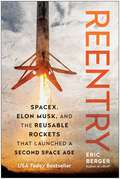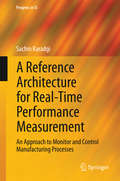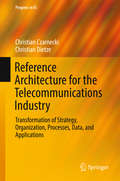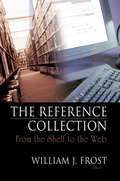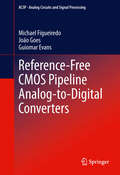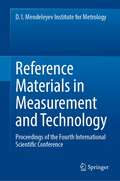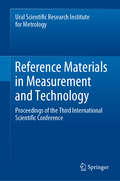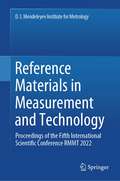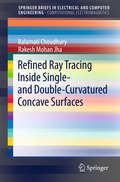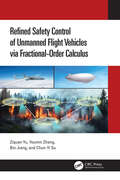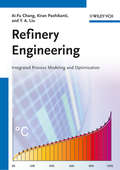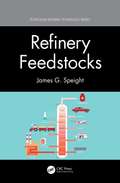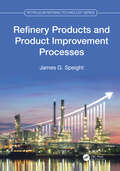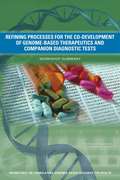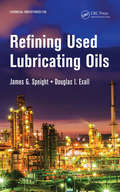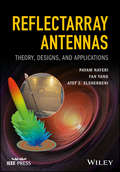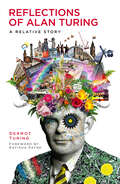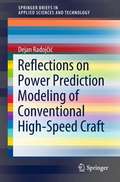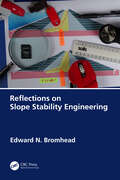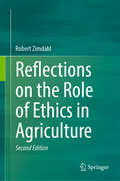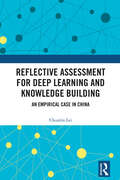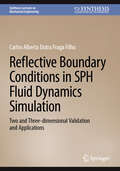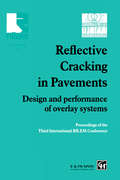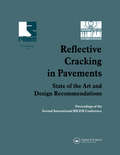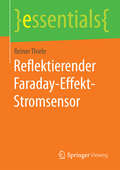- Table View
- List View
Reentry: SpaceX, Elon Musk, and the Reusable Rockets that Launched a Second Space Age
by Eric BergerFeatured in The Economist&’s Best Books of 2024 USA Today Bestseller How did a shaky startup defy expectations and become the world&’s leading spaceflight company? Get the untold story of the team of game-changers, led by a well-known billionaire, who are sending NASA astronauts to space—and just might carry the human race to Mars. One company dominates the modern space industry: SpaceX, founded by controversial entrepreneur Elon Musk in 2002, now sending more payloads into orbit than the rest of the world combined. But Musk didn&’t do it alone—the saga of SpaceX is the story of a diverse cadre of true believers in the limitless potential of space travel. For the first time, Reentry relates the definitive chronicle of how this daring team was able to redefine what it takes to reach the stars. With Pulitzer Prize–nominated journalist Eric Berger, author of Liftoff, as your guide, you&’ll accompany SpaceX&’s innovative thinkers during their toughest trials and most audacious moments, including: Creating the first orbital rockets that land by themselves and fly again Transporting a 120-foot rocket from Texas to Florida Recovering from a &“Hell&’s Bells&” accident before the first Falcon Heavy launch Frantically searching the ocean for the first rocket that splashed down intact Identifying the $20 part that led to a rocket exploding in flight Slicing up an engine days before it launched into space From launchpad explosions to a pernicious cricket infestation to the demanding management style of Musk himself, the rise of SpaceX was beset with challenges and far from inevitable. Find out how the startup beat the odds and flew high enough to outpace their rivals . . . and where they&’re going next.
A Reference Architecture for Real-Time Performance Measurement: An Approach to Monitor and Control Manufacturing Processes (Progress in IS)
by Sachin KaradgiThis book describes how manufacturing enterprises, by reinforcing their existing monitoring and control of manufacturing processes, can successfully face the ever-increasing pressure from internal and external environments to maintain their competitive advantage. Numerous performance measurement systems have been elaborated to satisfy these requirements, stressing the importance of financial and operational metrics. It also highlights the fact that research on generating and linking financial and operational metrics, especially in real-time, has not garnered sufficient attention to date. The book follows an approach that integrates enterprises across different levels and departments. By computing and linking the financial and operational metrics in real-time, the book demonstrates how to provide a comprehensive view of an entire enterprise.
Reference Architecture for the Telecommunications Industry
by Christian Czarnecki Christian DietzeThis book reflects the tremendous changes in the telecommunications industry in the course of the past few decades - shorter innovation cycles, stiffer competition and new communication products. It analyzes the transformation of processes, applications and network technologies that are now expected to take place under enormous time pressure. The International Telecommunication Union (ITU) and the TM Forum have provided reference solutions that are broadly recognized and used throughout the value chain of the telecommunications industry, and which can be considered the de facto standard. The book describes how these reference solutions can be used in a practical context: it presents the latest insights into their development, highlights lessons learned from numerous international projects and combines them with well-founded research results in enterprise architecture management and reference modeling. The complete architectural transformation is explained, from the planning and set-up stage to the implementation. Featuring a wealth of examples and illustrations, the book offers a valuable resource for telecommunication professionals, enterprise architects and project managers alike.
The Reference Collection: From the Shelf to the Web
by Linda S KatzStay up-to-date with the growing amount of reference resources available onlineHow important is the World Wide Web to information retrieval and communication? Important enough that information professionals have seen students exit from their libraries en masse when Internet service was lost. Internet providers dominate the indexing and abstracting of periodical articles as major publishers now offer nearly all of their reference titles in digital form. Libraries spend increasing amounts of funding on electronic reference materials, and librarians devote an increasing amount of time to assisting in their use. The Reference Collection: From the Shelf to the Web is an essential guide to collection development for electronic materials in academic and public libraries. The Reference Collection: From the Shelf to the Web tracks the continuing evolution of electronic reference resources-and how they&’re accessed-in a variety of settings. Librarians representing university, elementary school, and public libraries in the United States and Australia examine how reference collections have evolved over time (and may soon be a thing of the past); how public and school libraries have dealt with the changes; why library research assignments have become more difficult for teachers to make and for students to complete; how to organize online reference sources; and why the nature of plagiarism has changed in the electronic era. The book also examines the use of electronic references from a publisher&’s perspective and looks at the most important Web-accessible reference tools-both free and subscription-in the areas of humanities, medicine, the social sciences, business, and education. The Reference Collection: From the Shelf to the Web also examines: issues of authority, accessibility, cost, comfort, and user education in evaluating electronic resources the formation of purchasing consortia to facilitate the transfer of reference materials from print to online formats current literature and research findings on the state of digital versus print reference collections what electronic publishing means to smaller reference books (dictionaries, almanacs, etc.) the need for increased information literacy among students the nature, extent, and causes of cyber plagiarism the use of federated search tools and includes a selected list of the top 100 free Internet reference sitesThe Reference Collection: From the Shelf to the Web is an essential resource for all reference and collection development librarians, and an invaluable aid for publishing professionals.
Reference-Free CMOS Pipeline Analog-to-Digital Converters
by Michael Figueiredo João Goes Guiomar EvansThis book shows that digitally assisted analog to digital converters are not the only way to cope with poor analog performance caused by technology scaling. It describes various analog design techniques that enhance the area and power efficiency without employing any type of digital calibration circuitry. These techniques consist of self-biasing for PVT enhancement, inverter-based design for improved speed/power ratio, gain-of-two obtained by voltage sum instead of charge redistribution, and current-mode reference shifting instead of voltage reference shifting. Together, these techniques allow enhancing the area and power efficiency of the main building blocks of a multiplying digital-to-analog converter (MDAC) based stage, namely, the flash quantizer, the amplifier, and the switched capacitor network of the MDAC. Complementing the theoretical analyses of the various techniques, a power efficient operational transconductance amplifier is implemented and experimentally characterized. Furthermore, a medium-low resolution reference-free high-speed time-interleaved pipeline ADC employing all mentioned design techniques and circuits is presented, implemented and experimentally characterized. This ADC is said to be reference-free because it precludes any reference voltage, therefore saving power and area, as reference circuits are not necessary. Experimental results demonstrate the potential of the techniques which enabled the implementation of area and power efficient circuits.
Reference Materials in Measurement and Technology: Proceedings of the Fourth International Scientific Conference
by Olga N. Kremleva Egor P. Sobina Sergey V. Medvedevskikh Mikhail V. OkrepilovThe book covers in particular state-of-the-art scientific research about product quality control and related health and environmental safety topics, including human, animal and plant safety assurance issues. These conference proceedings provide contemporary information on the general theoretical, metrological and practical issues of the production and application of reference materials.Reference materials play an integral role in physical, chemical and related type of measurements, ensuring their uniformity, comparability and the validity of quantitative analysis as well as, as a result, the objectivity of decisions concerning the elimination of technical barriers in commercial and economic, scientific and technical and other spheres of cooperation. The book is intended for researchers and practitioners in the field of chemistry, metrologists, technical physics, as well as for specialists in analytical laboratories, or working for companies and organizations involved in the production, distribution and use of reference materials.
Reference Materials in Measurement and Technology: Proceedings of the Third International Scientific Conference
by Sergei V. Medvedevskikh Olga N. Kremleva Irina E. Vasil’eva Egor P. SobinaThe book covers in particular state-of-the-art scientific research about product quality control and related health and environmental safety topics, including human, animal and plant safety assurance issues. These conference proceedings provide contemporary information on the general theoretical, metrological and practical issues of the production and application of reference materials.Reference materials play an integral role in physical, chemical and related type of measurements, ensuring their uniformity, comparability and the validity of quantitative analysis as well as, as a result, the objectivity of decisions concerning the elimination of technical barriers in commercial and economic, scientific and technical and other spheres of cooperation. The book is intended for researchers and practitioners in the field of chemistry, metrologists, technical physics, as well as for specialists in analytical laboratories, or working for companies and organizations involved in the production, distribution and use of reference materials.
Reference Materials in Measurement and Technology: Proceedings of the Fifth International Scientific Conference RMMT 2022
by Egor P. Sobina Sergey V. Medvedevskikh Olga N. Kremleva Ivan S. Filimonov Elena V. Kulyabina Anna V. Kolobova Andrey V. Bulatov Vladimir I. DobrovolskiyThe book covers in particular state-of-the-art scientific research about product quality control and related health and environmental safety topics, including human, animal and plant safety assurance issues. These conference proceedings provide contemporary information on the general theoretical, metrological and practical issues of the production and application of reference materials.Reference materials play an integral role in physical, chemical and related type of measurements, ensuring their uniformity, comparability and the validity of quantitative analysis as well as, as a result, the objectivity of decisions concerning the elimination of technical barriers in commercial and economic, scientific and technical and other spheres of cooperation. The book is intended for researchers and practitioners in the field of chemistry, metrologists, technical physics, as well as for specialists in analytical laboratories, or working for companies and organizations involved in the production, distribution and use of reference materials.
Refined Ray Tracing inside Single- and Double-Curvatured Concave Surfaces
by Balamati Choudhury Rakesh Mohan JhaThis book describes the ray tracing effects inside different quadric surfaces. Analytical surface modeling is a priori requirement for electromagnetic (EM) analysis over aerospace platforms. Although numerically-specified surfaces and even non-uniform rational basis spline (NURBS) can be used for modeling such surfaces, for most practical EM applications, it is sufficient to model them as quadric surface patches and the hybrids thereof. It is therefore apparent that a vast majority of aerospace bodies can be conveniently modeled as combinations of simpler quadric surfaces, i. e. hybrid of quadric cylinders and quadric surfaces of revolutions. Hence the analysis of geometric ray tracing inside is prerequisite to analyzing the RF build-up. This book, describes the ray tracing effects inside different quadric surfaces such as right circular cylinder, general paraboloid of revolution (GPOR), GPOR frustum of different shaping parameters and the corresponding visualization of the ray-path details. Finally ray tracing inside a typical space module, which is a hybrid of a finite segment of right circular cylinder and a frustum of GPOR is analyzed for practical aerospace applications.
Refined Safety Control of Unmanned Flight Vehicles via Fractional-Order Calculus
by Ziquan Yu Youmin Zhang Bin Jiang Chun-Yi SuThe monograph explores the safety of unmanned flight vehicles via the corresponding fault-tolerant control design methods. The authors analyse the safety control issues of unmanned flight vehicles, which include finite-time recovery against faults, concurrence of actuator faults and sensor faults, concurrence of actuator faults and wind effects, and faults encountered by a portion of unmanned flight vehicles in a distributed communication network. In addition, the commonly used simple but effective proportional-integral-derivative structure is also incorporated into the safety control design for unmanned flight vehicles. By using the fractional-order calculus, the developed safety control results are able to ensure flight safety and achieve the refined performance adjustments against faults and wind effects. The book will be of interest to 3rd/4th year undergraduate students, postgraduate and graduate students, researchers, academic staff, engineers of aircraft and unmanned flight vehicles.
Refinery Engineering
by Ai-Fu Chang Kiran Pashikanti Y. A. LiuPetroleum refining is one of the most important yet challenging industries, and continues to be a major contributor in the production of transportation fuels and chemicals. Current economic, regulatory and environmental concerns place significant pressure on refiners to upgrade and optimize the refining process. At the same time, new product demands are urging refiners to explore alternative processing units and feedstocks. This textbook represents a pioneering and comprehensive introduction to this complex subject, using many of the tools and techniques currently employed in modern refinery process simulation Adopting a systematic and practical approach, the authors include the theory, case studies and hands-on workshops, explaining how to work with real data. As a result, senior-level undergraduate and graduate students, as well as industrial engineers learn how to develop and use the latest computer models for the predictive modeling and optimization of integrated refinery processes. Additional material is available online providing relevant spreadsheets and simulation files for all the models and examples presented in the book.
Refinery Feedstocks (Petroleum Refining Technology Series)
by James G. SpeightOver the last several decades, the petroleum industry has experienced significant changes in resource availability, petro-politics, and technological advancements dictated by the changing quality of refinery feedstocks. However, the dependence on fossil fuels as the primary energy source has remained unchanged. Refinery Feedstocks addresses the problems of changing feedstock availability and properties; the refining process; and solids deposition during refining. This book will take the reader through the various steps that are necessary for crude oil evaluation and refining including the potential for the use of coal liquids, shale oil, and non-fossil fuel materials (biomass) as refinery feedstocks. Other features: Describes the various types of crude oil and includes a discussion of extra heavy oil and tar sand bitumen Includes basic properties and specifications of crude oil and the significance in refinery operations This book is a handy reference for engineers, scientists, and students who want an update on crude oil refining and on the direction the industry must take to assure the refinability of various feedstocks and the efficiency of the refining processes in the next fifty years. Non-technical readers, with help from the extensive glossary, will also benefit from reading this book.
Refinery Products and Product Improvement Processes (Petroleum Refining Technology Series)
by James G. SpeightThis book focuses on the various refinery products, product improvement processes, and solvent processes that are used in the refining industry and the processes used in product improvement to ensure products meet sales specifications. This accessible book is written for engineers, scientists, students, and academics wanting an update on crude oil processing and insight into the direction of the industry.Key features:• Describes the development of technologies for a variety of feedstocks, including heavy feedstocks utilizing advanced pre-treatment processing and hydrotreating.• Presents the initial refining processes and prepares for the new changes and evolution of the industry, including the role of biomass in the future refinery. • Analyses catalyst deactivation mechanism for developing optimum technologies for processing feedstocks with low reactivity.• Includes an extensive glossary which will be beneficial for non-technical readers.
Refining Processes for the Co-Development of Genome-Based Therapeutics and Companion Diagnostic Tests
by Sarah H. BeachyMany drug developers have examined new strategies for creating efficiencies in their development processes, including the adoption of genomics-based approaches. Genomic data can identify new drug targets for both common and rare diseases, can predict which patients are likely to respond to a specific treatment, and has the potential to significantly reduce the cost of clinical trials by reducing the number of patients that must be enrolled in order to demonstrate safety and efficacy. A key component of the approval of targeted therapeutics is the ability to identify the population of patients who will benefit from treatment, and this has largely hinged on the co-development and co-submission to the FDA of a companion diagnostic test. The co-development process, or the development of the test and drug for the simultaneous submission to FDA, has led to a major alteration in the way that drugs are being developed, with traditionally separate entities--pharmaceutical and diagnostic companies--now working in close collaboration. Refining Processes for the Co-Development of Genome-Based Therapeutics and Companion Diagnostic Tests is the summary of a workshop held by the Roundtable on Translating Genomic-Based Research for Health on February 27, 2013 to examine and discuss challenges and potential solutions for the codevelopment of targeted therapeutics and companion molecular tests for the prediction of drug response. Prior to the workshop, key stakeholders, including laboratory and medical professional societies, were individually asked to provide possible solutions to resolve the concerns raised about co-development of companion diagnostic tests and therapies. Workshop speakers were charged with addressing these solutions in their presentations by providing insight on (1) whether the proposed solutions address the problems described, (2) whether there are other solutions to propose, and (3) what steps could be taken to effectively implement the proposed solutions.
Refining Used Lubricating Oils (ISSN)
by James Speight Douglas I. ExallUsed lubricating oil is a valuable resource. This book examines recycling processes for a range of products with different properties and different criteria. It also compares the various recycling methods and resulting products to conventional products obtained from original refining processes. The reviews, data, and comparisons provided by the authors allow readers to identify which processes are likely to produce a product with specific properties, and enable them to combine this with an analysis of the economic data to identify attractive oil recycling propositions.
Reflectarray Antennas: Theory, Designs, and Applications (Wiley - IEEE)
by Payam Nayeri Fan Yang Atef Z. ElsherbeniThis book provides engineers with a comprehensive review of the state-of-the-art in reflectarray antenna research and development. The authors describe, in detail, design procedures for a wide range of applications, including broadband, multi-band, multi-beam, contour-beam, beam-scanning, and conformal reflectarray antennas. They provide sufficient coverage of basic reflectarray theory to fully understand reflectarray antenna design and analysis such that the readers can pursue reflectarray research on their own. Throughout the book numerous illustrative design examples including numerical and experimental results are provided. Featuring in-depth theoretical analysis along with practical design examples, Reflectarray Antennas is an excellent text/reference for engineering graduate students, researchers, and engineers in the field of antennas. It belongs on the bookshelves of university libraries, research institutes, and industrial labs and research facilities.
Reflections of Alan Turing: A Relative Story
by Dermot TuringEveryone knows the story of the codebreaker and computer science pioneer Alan Turing.Except …When Dermot Turing is asked about his famous uncle, people want to know more than the bullet points of his life. They want to know everything – was Alan Turing actually a codebreaker? What did he make of artificial intelligence? What is the significance of Alan Turing’s trial, his suicide, the Royal Pardon, the £50 note and the film The Imitation Game?In Reflections of Alan Turing, Dermot strips off the layers to uncover the real story. It’s time to discover a fresh legacy of Alan Turing for the twenty-first century.
Reflections on Power Prediction Modeling of Conventional High-Speed Craft (SpringerBriefs in Applied Sciences and Technology)
by Dejan RadojčićThis SpringerBrief focuses on modeling and power evaluation of high-speed craft. The various power prediction methods, a principal design objective for high-speed craft of displacement, semi-displacement, and planing type, are addressed. At the core of the power prediction methods are mathematical models for resistance and propulsion efficiency. The models are based on the experimental data of various high-speed hull and propeller series. The regression analysis and artificial neural network (ANN) methods are used as an extraction tool for this kind of mathematical models. A variety of mathematical models of this type are discussed in the book.Once these mathematical models have been developed and validated, they can be readily programmed into software tools, thereby enabling the parametric analyses required for the optimization of a high-speed craft design. This book provides the foundational reference for these software tools, and their use in the design of high-speed craft. High-speed craft are very different from conventional ships. Current professional literature leaves a gap in the documentation of best design practices for high-speed craft. This book is aimed at naval architects who design and develop various types of high-speed vessels.
Reflections on Slope Stability Engineering
by Edward N. BromheadSlope stability engineering is both an art and a science practised by many civil and geotechnical engineers involved in work on landslides, earth dams, breakwaters, coastal defence, earthworks slopes for roads, canals, railways, pipelines, housing developments, and other related developments. This book contains the detailed reflections of its author, who has practised and researched in the field for over a half-century. It is written in an informal style that makes it an interesting and thought-provoking practitioner guide to landslides and slope problems and their investigation, analysis, and remediation, considering both natural and man-made slopes and earthworks, and without the need for the usual equations and illustrations. Reflections on Slope Stability Engineering is targeted primarily at practitioners working in the investigations of slope instability and the design and construction of treatments of the problem, especially those early in their careers, but the accessible style also suits students who are developing an interest in the subject and even those engineers with only a casual interest in this branch of geotechnics.
Reflections on the Role of Ethics in Agriculture
by Robert ZimdahlThis volume is an update to Weed Science- A Plea for Thought-Revisited published by Springer in 2012. More than a decade after the first edition, ethical discussion on the use of pesticides for weed management is largely absent. Startingly, weed science and agriculture have continued on the same path and are still dominated by capital chemical and energy intensive practices, including the paralysis of pesticides. This second edition expands upon the first, using recent data to confirm the dominance of herbicides. The revision includes chapters which emphasize the role of ethics in agriculture and the reasons it should, but has not yet become part of agricultural education. This includes suggestions on how education in agricultural ethics should be shifting and whose responsibility it is. The revised version also includes a discussion on the role of genetically modified crops and the consequences of using these crops-both positive and negative. Scientists have developed a wealth of knowledge they bring to the surface of their disciplinary silos. Yet there needs to be greater discussion on the necessity and risks of agricultural science and technology. This revised version provides a rigorous examination of weed science’s goals and ethics and challenges the way we manage weeds and agriculture.
Reflective Assessment for Deep Learning and Knowledge Building: An Empirical Case in China
by Chunlin LeiKnowledge building aims to transform schools into learning communities and bring knowledge creation into schools. The book therefore elaborates on how learning, technology, and assessment can be aligned both online and offline to facilitate such a process.Adopting a quasi-experimental design and drawing on rich data from forum discussions, questionnaires, interviews, learning outcomes, and classroom presentations, this book shows that the knowledge building environment, augmented by reflective assessment and principles, helped Chinese students to develop a deeper approach to learning, improved academic performance, and promoted collective knowledge advances. The book also discusses the potentials and challenges of designing technology-supported, assessment- and principle-based learning environments in tertiary contexts, especially when deep learning and knowledge building capacity are greatly emphasised in the knowledge era.The book will be of interest to scholars and educators working in learning sciences and computer-supported collaborative learning.
Reflective Boundary Conditions in SPH Fluid Dynamics Simulation: Two and Three-dimensional Validation and Applications (Synthesis Lectures on Mechanical Engineering)
by Carlos Alberto Fraga FilhoThis book presents results from applying Reflective Boundary Conditions (RBC) in particle simulations coupled with the Smoothed Particle Hydrodynamics (SPH) Method in two- and three-dimensional domains. The contribution of this work lies in the presentation of the state of the art regarding the application of physical and realistic boundary conditions in the continuum domain, which is an advance in the artificial computational boundary treatment carried out in most SPH simulations. By reading this work, researchers from different fields dealing with Computational Fluid Dynamics (CFD) will be aware of the most recent results of applying the SPH method coupled with RBC, confirming its scientific validity and encouraging its implementation in other problems. This multidisciplinary work is aimed at undergraduate and postgraduate students, researchers, software developers, and other engineering, physics, chemistry, mathematics, and related sciences professionals.
Reflective Cracking in Pavements: Design and performance of overlay systems
by L. Francken E. Beuving A.A.A. MolenaarProceedings of RILEM TC-PRC third conference on this subject. Papers from road authorities, engineers, researchers, contractors and manufacturers discussing the implementation and the long term behaviour of overlay systems. The following topics are covered: prevention and cracking assessment, choice and design of overlay systems, practical implemen
Reflective Cracking in Pavements: State of the Art and Design Recommendations
by J. M. Rigo L. FranckenThis book forms the Proceedings of the Second International RILEM Conference held in Liege in March 1993. It follows the successful first conference held in 1989 and focusses on two main topics: the current state of the art of reflective cracking in highway and other pavements, and design recommendations for field applications. As well as more than 50 international contributions on individual projects, a series of keynote papers are included.
Reflektierender Faraday-Effekt-Stromsensor (essentials)
by Reiner ThieleReiner Thiele hat durch die Applikation des Faraday-Effektes zur Polarisations-Ebenen-Drehung linear polarisierten Lichts in Lichtwellenleitern, induziert durch das den stromführenden elektrischen Leiter umgebende Magnetfeld, eine Lösung gefunden, hohe elektrische Ströme ohne Eingriff in den Messgrößenkreis zu messen. Dies stellte bisher ein grundsätzliches Problem der elektrischen Energietechnik dar. Eine in Reflexion arbeitende erfindungsgemäße Schaltungsanordnung aus optischen und elektronischen Komponenten stellt dabei den gewünschten linearen Zusammenhang zwischen Messgröße und Messwert bei Elimination der störenden Doppelbrechung der Lichtwellenleiter her, die sich ansonsten vermindernd auf die Effizienz des Faraday-Effektes auswirkt.
